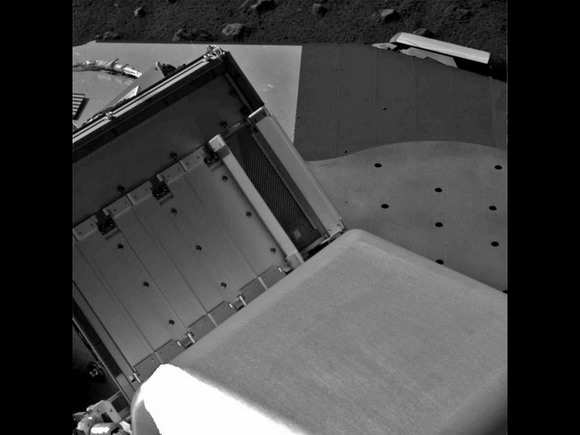[/caption]
For the first time, the Phoenix lander stayed up all night. But there was no partying for the little lander, just hard work. Phoenix coordinated its schedule to work together with the Mars Reconnaissance Orbiter to make joint observations to study Mars’ atmosphere. More on that in a minute, but the other big news from the Phoenix lander is that the doors to the Thermal and Evolved Gas Analyzer (TEGA) oven successfully opened, and the device is now ready to accept a sample of icy soil. If you remember, way back in the beginning of the mission, on about Sol 8, the first time the science team relayed orders for the spring-loaded oven doors to open, the doors only opened partially and the team had to vibrate the oven to get the soil inside. But this time, the 10 cm (4 inch) doors stands wide open, and today Phoenix will perfect its techniques to quickly get the icy soil sample inside the oven before the ice sublimates.
Now, about those atmospheric observations: Phoenix used its weather station, stereo camera and conductivity probe to monitor changes in the lower atmosphere and ground surface at the same time MRO studied the atmosphere and ground from above. The orbiter flew repeatedly over Phoenix’s location last evening, so it was good timing for a coordinated effort.
“We are looking for patterns of movement and phase change,” said Michael Hecht, lead scientist for Phoenix’s Microscopy, Electrochemistry and Conductivity Analyzer, which includes the lander’s fork-like thermal and conductivity probe. “The probe is working great. We see some changes in soil electrical properties, which may be related to water, but we’re still chewing on the data.”
The probe was inserted into the soil Sunday for more than 24 hours of measurements coordinated with the atmosphere observations. One goal is to watch for time-of-day changes such as whether some water alters from ice phase to vapor phase and enters the atmosphere from the soil.
The Phoenix team’s plans also include commanding the lander to conduct additional testing of the techniques for collecting a sample of icy soil. When the team is confident about the collecting method, it plans to use Phoenix’s robotic arm to deliver an icy sample to an oven of TEGA.
The team wants to make sure their techniques will quickly bring the soil into the oven, as it’s possible the oven will only work for one more test. The vibrating done to get the soil into the oven for the previous test caused a short circuit that may happen again the next time the oven is activated. The short could be fatal to the oven, but of course, we’re all still holding out hope for a better case scenario.
Original News Source: Phoenix News site


the doors only opened partially and the team had to vibrate the oven to get the soil inside.
Those statements are both true, but not related. They had to vibrate the oven to get the soil to drop through the mesh behind the doors. So they may well have to vibrate again, which is why they are worried about shorting.
I wonder if any observations of Martian meteors were attempted as the article states the stereo camera was in operation at the time? I seem to remember that meteor observing attempts were to be made by Phoenix at some point in the mission.
After seeing the ‘midnight sun’ story from July 23, I guess no meteor observations were made. I forgot to envision the solar day from Phoenix’s high latitude. But I still remember reading something about Martian meteor observations to be conducted by the Phoenix lander. Is this at all possible?